Saving butterflies, moths and our environment
Celebrating our 40th Anniversary!
1982 - 2022
Portsdown Ramblings. After my success at finding a Brown Hairstreak on Portsdown Hill a couple of weeks ago I have made several more visits without success - until today. I wasn’t very hopeful as despite the sun there was a gusty north east wind blowing and for that reason I concentrated on south facing blackthorn stands that had some shelter. There is a great crop of blackberries this year and after about an hour I stopped to wipe the blackberry juice off my fingers and lo and behold a slightly battered female emerged from the blackthorn to take some sun. I watched her for about 30mins laying four or five eggs and resting up in between her efforts - something I never thought I would see right on my doorstep. Later on in the rather optimistic hope that there might be some rare migrants I had a look around the slopes in front of the fort which turned up half a dozen nice Clouded Yellows but nothing more uncommon. However one female was laying eggs on Birds Foot Trefoil which I haven’t observed before. I wonder how they will get on? [Posted by Mark Tutton]
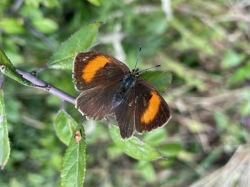 | 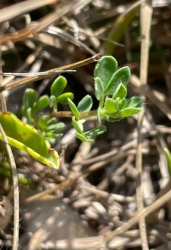 |
| Brown Hairstreak Photo © Mark Tutton | Clouded Yellow egg Photo © Mark Tutton |
Monks Walk, Frater Fields & Woods, Gosport. A pleasing increase of two species (to 12) from that of 48 hours ago including my first year's sighting here of Small Heath. Second brood Green-veined White was also seen today, both male and female being recorded. From 1130-1500 (23.5 deg C in warm sunshine) and unaffected by the forceful SSE breezes. Total: Small White (6); Green-veined White (F)(3)(M)(2); Large White (6); Speckled Wood (M)(13)(F)(2); Small Copper (4); Meadow Brown (F)(3); Common Blue (M)(8); Holly Blue (M)(7)(F)(3); Red Admiral (2); Comma (2); Small Heath (1); Brown Argus (2). [Posted by Francis Plowman]
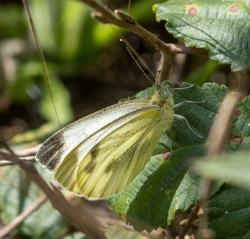 | 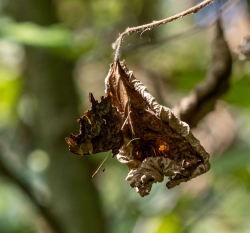 | 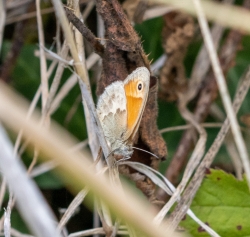 |
| Female Green-veined White Photo © Francis Plowman | Comma in camouflage Photo © Francis Plowman | Somewhat shy Small Heath Photo © Francis Plowman |
Beacon Hill NNR Field Trip. With the Field Trip programme now drawing to a close the species on the downs were very few and far between on Beacon Hill NNR near Exton today. Perfect weather although there was a stiff breeze in the open areas, so it was imperative to get in shelter if that was possible. The wild flowers were also very sparse, the best counts today were the lovely Brown Argus, seen in amongst the footpaths dotted around the fort on the Eastern side. One Silver-spotted Skipper was seen and she was fortunately seen laying her eggs on Sheeps Fescue. It would seem that the species still hasn't really re-established itself over from Old Winchester Hill, and some hard sheep and cattle bashing of the grasses still looks the best option. Other species seen were Comma, Speckled Wood, Red Admiral, Common Blue, battered Chalk Hill Blues, and the odd Meadow Brown. No Clouded Yellows or Adonis Blues were seen but that's not to say they were not there. Good views of Kestrels hovering on the breeze and Red Kites were patrolling and rising on the thermals, we also had a Hare bolt for cover on the chalk escarpment, when some of us braved the slope to get to the bottom! It will be interesting how many species will cope next year if the weather is the same as this year. I'd like to thank all who came today. [Posted by Ashley Whitlock]
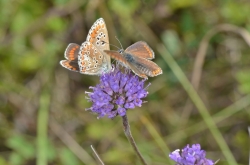 | 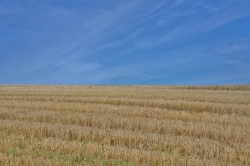 | 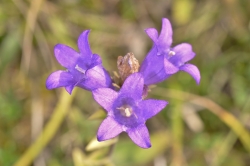 |
| Brown Argus on Scabious Photo © Ashley Whitlock | Beacon Hill facing north Photo © Ashley Whitlock | Clustered Bellflower Photo © Ashley Whitlock |
Monks Walk, Frater Fields & Woods, Gosport. Almost a fortnight since my last survey of Monks Walk when I reported on my first Summer sighting here of Small Copper, today's three-hours' wander from 2.40 pm produced at least nine and all very fresh and quite large individuals. They were joined by nine other species found across the northern sector with the butterfly meadow and adjoining 'navy field' producing the majority of species. A jittery and diminutive Brown Argus was hard to photograph; it was clearly tinier than a Small Blue. The illustrated Common Blue showed such flashes of violet in the sunshine that I first thought of Adonis Blue. It was an eye-catching moment and the photograph is shown 'as taken'. Thus a warm and thoroughly enjoyable walk under full sunshine. Total: Large White (6); Holly Blue (7)(incl 1xF); Common Blue (M)(6)(F)(1); Meadow Brown (3); Small Copper (9); Brown Argus (3); Small White (5); Red Admiral (1); Comma (2); Speckled Wood (M)(2). [Posted by Francis Plowman]
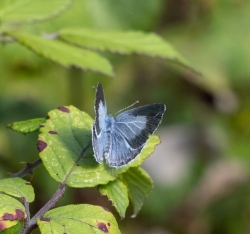 | 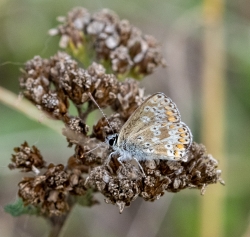 | 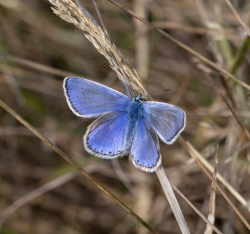 |
| Female Holly Blue Photo © Francis Plowman | Tiny Brown Argus Photo © Francis Plowman | Common Blue male Photo © Francis Plowman |
Fort Widley, Portsdown Hill. From 1300-1330 (23 deg C cloudy) seven species were seen although none in high numbers. There is still plenty of field and hedgerow flora but there had been heavy rain recently judging by the car park puddles. I had hoped to see a late emergence of Small Blue but was unsuccessful in that aim. I watched a very large female Brimstone trying to find a suitable laying site but she never once settled. Total: Meadow Brown (2); Small White (5); Large White (2); Speckled Wood (M) (1); Brimstone (F)(1); Common Blue (M)(3); Brown Argus (2). [Posted by Francis Plowman]
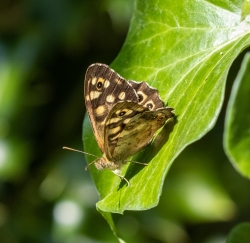 | 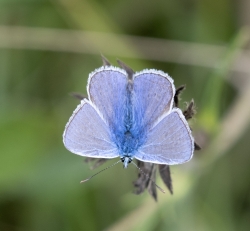 | 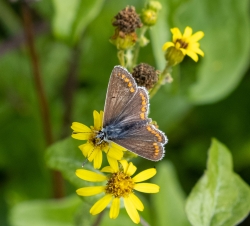 |
| Speckled Wood male Photo © Francis Plowman | Common Blue male Photo © Francis Plowman | Brown Argus Photo © Francis Plowman |
Portsdown Hill (East), Paulsgrove. Crossing the road below Fort Widley and tracking left before, at the bordered woodland, returning via a slightly lower path, from 1330-1420 just five species were counted. The sun had become obscured by grey cloud and temperature around 20 degrees Celsius. Total: Common Blue (F)(1); Meadow Brown (15); Chalk Hill Blue (F)(1); Small White (3); Holly Blue (1). [Posted by Francis Plowman]
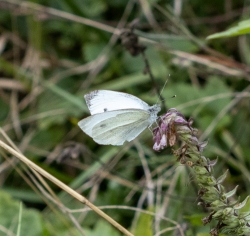 | 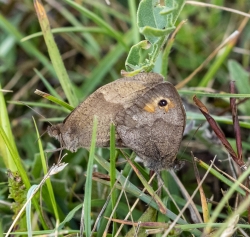 |
| Small White male awaits the sunshine! Photo © Francis Plowman | Meadow Brown female at left Photo © Francis Plowman |
Portsdown Hill (West), Paulsgrove. From 1430-1630 nine species were recorded under cloudy skies initially but later warm sunshine around 23 degrees Celsius. Total: Large White (8); Small White (20); Meadow Brown (151); Red Admiral (1); Brown Argus (4); Common Blue (M)(11)(F)(3); Chalk Hill Blue (F)(11)(M)(4); Holly Blue (1); Small Heath (1). [Posted by Francis Plowman]
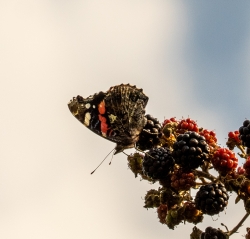 | 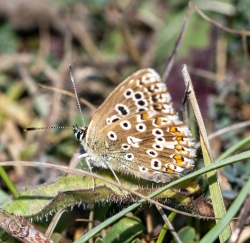 | 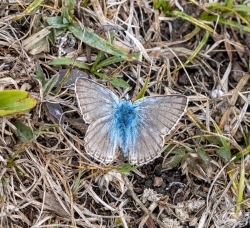 |
| Red Admiral atop blackberries Photo © Francis Plowman | Chalk Hill Blue female Photo © Francis Plowman | Chalk Hill Blue male, very worn now Photo © Francis Plowman |
Clouded Yellows at King's Somborne. Earlier this afternoon I was very pleased to find a number of Clouded Yellow, mainly in two fields of unharvested oilseed rape (?) and clover. The clover field is best viewed from the junction of Cow Hill Drove and How Park track - looking down towards the village. The other field, of rape (?), can be viewed from the end of the track - near How Park Farm. After watching the area for about half an hour, I reckon there were at least 10. [Posted by Philip Hack]
Back Garden near Portsmouth. The Buddleia is still producing flowers in my back garden and consequently attracting a lot of insects. Yesterday I had two Hummingbird Hawkmoths buzzing around flitting from flower to flower, and today I've counted three, what a triumph! Fascinating to watch them and it's one of those insects you never tire of seeing. One of the moths was obviously in need of some rest and came to perch on my 'Arbour' and it blended into the wood colour of the 'Arbour' perfectly. It stayed there for a good 15 minutes until it was off again feeding on the purple flowers of my buddleia [Posted by Ashley Whitlock]
Martin Down National Nature Reserve South. A very long walk around the southern segment of the nature reserve realised a count of eleven species. The temperature ranged from 20-23.5 deg C on our pleasant journeying from 1110-1425 by which time clouds had obscured the sun and butterfly activity diminished considerably. Meadow Brown held top honours today with Chalk Hill Blue numerous but showing signs of wear with good numbers of Adonis Blue. Small Heath was also well represented but only one male Clouded Yellow was seen. Total: Small White (14); Meadow Brown (192); Common Blue (M)(14)(F)(8); Chalk Hill Blue (M)(35)(F)(78); Adonis Blue (M)(40)(F)(20); Small Heath (76); Large White (M)(8)(F)(2); Brown Argus (22); Small Copper (1); Holly Blue (1); Clouded Yellow (1). [Posted by Francis Plowman]
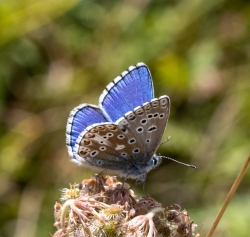 | 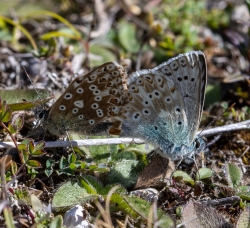 | 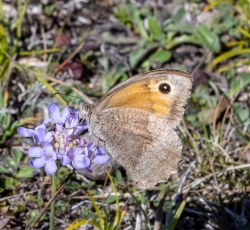 |
| Adonis Blue male Photo © Francis Plowman | Chalk Hill Blue male at right Photo © Francis Plowman | Female Meadow Brown - one of the 192! Photo © Francis Plowman |
Oxenbourne Down. A look around Oxenbourne Down today revealed that the Silver-Spotted Skippers had almost disappeared, with just 8 being seen on the wing. However the Adonis Blue seems to have come on leaps and bounds with about 8 males seen with one drying its wings. No females as yet. There were a lot of Common Blues and Chalk Hill Blues still on the wing with Small Heath. There wasn't much else, but some of the wild flowers had perked up a bit as the welcome rain must have done some good. A lovely Bordered Straw Moth was seen which is a migrant and I hadn't seen one of these before, a beautiful moth especially the underwing a lacy grey colour, it looked as if it was wearing a pair of Victorian pantaloons! [Posted by Ashley Whitlock]
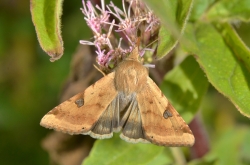 | 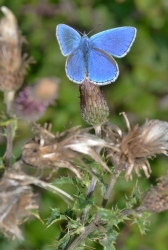 | 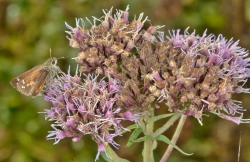 |
| Bordered Straw Moth an uncommon migrant Photo © Ashley Whitlock | Adonis Blue Male Photo © Ashley Whitlock | Silver Spotted Skipper Photo © Ashley Whitlock |
Butser Hill Field Trip. Another field trip and the weather was all gloomy with solid cloud overhead and was quite cool to start with. However as we made our way down to the bottom of Butser Hill the sun started to break through and the clouds started to disperse, and in the brown vegetation the butterflies were very active making hay whilst the sun shone. We had encountered a flock of what looked like Willow Warblers on the way down and these were flitting through the Elderberry bushes, and once we had got to the bottom the Meadow Brown and Common Blue counts went through the roof. Most of the wild flowers had died off due to lack of rain, but they were finding Marjoram and Oxford Ragwort as foodplants. The Adonis Blue were in good numbers about 20 odd were seen most of these were males, this is a species I had noted here in the early 2000's and now it seems to have established itself. Also noted were a few Silver-spotted Skippers on the short turf behind the shrubbery area, another species I had noted here in the 1990's but I think it hasn't been noted here that often as the terrain to get to it is quite tough, still I was glad to see it was still here. Clouded Yellows also gave us the run around with about four being noted. With the weather came Kestrels hunting on the top of the hillside about 4 hovering over the top of the downs also Buzzards were screaming as well from the young Beech and dying Ash trees at Grandfather's Bottom. Other species of note were a Orange Swift Moth, Silver-Y Moths, Brown Argus, Small Heath and the Chalk Hill Blue were just hanging on.
It took a lot of effort to get back up to the top but we all made it and I like to thank all who came and made this one of the most interesting walks I've completed in 2022. [Posted by Ashley Whitlock]
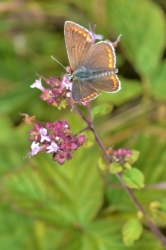 | 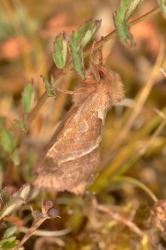 | 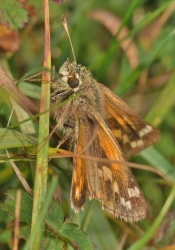 |
| Brown Argus Photo © Ashley Whitlock | Orange Swift Moth Photo © Ashley Whitlock | Female Silver Spotted Skipper Photo © Ashley Whitlock |
Moth trap in my garden at Leigh Park. I had my moth trap on overnight in my garden at Leigh Park. I caught 34 species, some of the highlights included a Jersey Tiger, 16 L-album Wainscot, 14 White Point, 7 Straw Underwing, 76 Vine's Rustic, 6 Tree-lichen Beauty, 4 Dwarf Cream Wave, 6 Rush Veneer, 20 Setaceous Hebrew Character etc. Also some unwelcome visitors in the trap which were devouring quite a few moths included 18 Hornets and 10 Wasps. [Posted by Barry Collins]
Browndown (South) Gosport. Surprisingly the flagpole by the Elmore gate was not displaying a red flag so between 1415-1630 we set out for a circulation though not with particularly high hopes. However, some nine species were noted including Grayling and Small Heath. The temperature was 24 deg C and the warm SE-breeze off The Solent was welcome. No model aircraft flying today so access to the meadow was open. Total: Large White (7); Small White (6); Brown Argus (1); Small Heath (9); Holly Blue (5); Small Copper (2); Grayling (3); Meadow Brown (3); Common Blue (F)(1)(M)(1). [Posted by Francis Plowman]
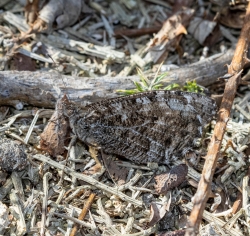 | 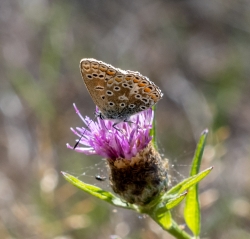 | 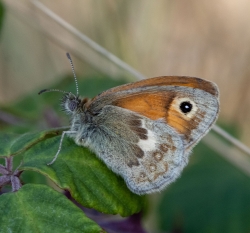 |
| Grayling female Photo © Francis Plowman | Common Blue female Photo © Francis Plowman | Small Heath Photo © Francis Plowman |
Browndown Coastal Area, Elmore, Gosport. From 1340-1410 we circulated the narrow strip of scrubland bordering Browndown South and the Lee-on-the-Solent main road. The temperature was a comfortable 24 degrees Celsius with a fairly strong and warm breeze from the south-east. We did not see the hoped-for Long-tailed Blue recently reported in the area although a Clouded Yellow was the second butterfly of the day to be counted. Total: Small White (4); Clouded Yellow (1); Large White (5); Small Heath (1); Holly Blue (3); Comma (1). [Posted by Francis Plowman]
Broughton Down Field Trip. A Change of day again because of the weather, but it did pay off as we had a lot of sunshine although it was a bit breezier today, however the Silver-spotted Skippers were a triumph, and a few Adonis Blues were dotted about which was rather pleasing. The Chalk Hill Blue on site is now fading fast, and the butterfly count was quite low, due to the fact I think everything is desperate for rain and are having a hard time at the moment. There was plenty of bird life to see and Buzzards, Red Kites and Kestrels were seen over the far side of the down. We didn't manage to see the Brown Hairstreak I think the wind probably kept any sightings down. I had to leave early and those who stayed on saw Clouded Yellows in another meadow. I'd like to thank all who endured the walk up and down to get to this site. I'd forgotten how arduous it was after a few absent years! [Posted by Ashley Whitlock]
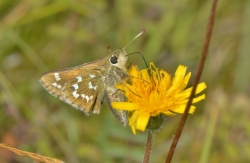 | 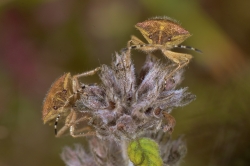 | 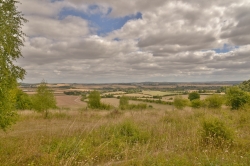 |
| Silver Spotted Skipper on Hawkbit Photo © Ashley Whitlock | Shield Bugs Photo © Ashley Whitlock | The great Hampshire landscape from Broughton Down Photo © Ashley Whitlock |
Long-tailed Blue in my Isle of Wight Garden.. At Freshwater today this female Long-tailed Blue on established Everlasting Sweet pea in my garden. The last female LTB recorded on same plant was on the 23rd August 2019. [Posted by Peter Hunt]
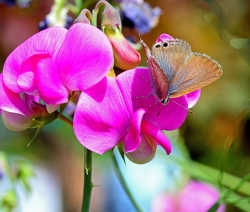 | 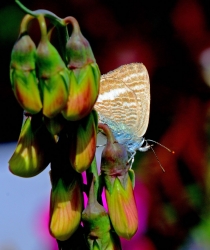 | 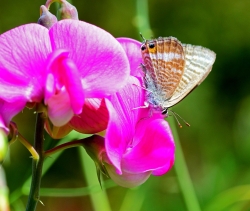 |
| Photo © Peter Hunt | Photo © Peter Hunt | Photo © Peter Hunt |
Shipton Bellinger, South Tidworth. Our first visit to this location today proved interesting and rewarding (eleven species). From 1040-1415 (with a lunch break) we covered the area shown in our indispensable 'Hampshire and Isle of Wight Butterfly Walks' guide. Leaving Gosport in heavy rain, the forecast bright sunshine for Tidworth proved accurate (23 deg C) with quite a refreshing breeze. The day's highlight was the prominent Wall the last species of which I had seen earlier this summer in Germany and in 2021, on the Isle of Wight! The Brown Hairstreak was less conspicuous throughout and conversations with other searchers found the same. Total: Small White (10); Red Admiral (2); Brown Hairstreak (2); Holly Blue (2); Meadow Brown (50); Wall (9); Small Heath (6); Common Blue (M)(5)(F)(2); Gatekeeper (1); Speckled Wood (22); Large White (2). [Posted by Francis Plowman]
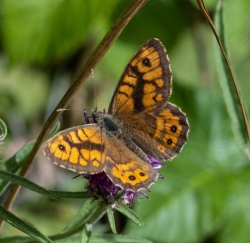 | 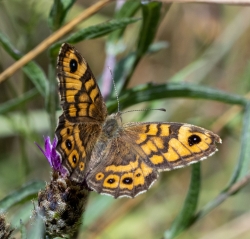 | 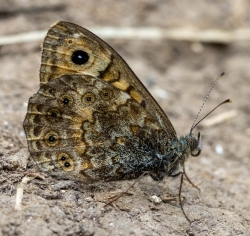 |
| Wall male Photo © Francis Plowman | Wall female Photo © Francis Plowman | Wall, resting & tolerant! Photo © Francis Plowman |
Humming bird Hawkmoth. A red letter day for seeing this amazing moth. Took our grandsons to the local fun fair in Lee on Solent Friday evening and saw two in town on Red Valerian. Then found another two in our garden when returning home - this time on Verbena. Fortunately one stayed long enough to get very good views - but difficult to photograph in failing light (after 7 pm) and with their rapid flight. The grandchildren were mesmerised by them! [Posted by Mark Wagstaff]
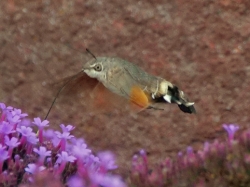 | 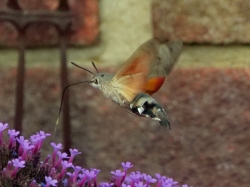 |
| Humming bird Hawkmoth - Lee on Solent Photo © Mark Wagstaff | Humming bird Hawkmoth - Lee on Solent Photo © Mark Wagstaff |
Shipton Bellinger Field Trip. A field trip which had to be hastily rearranged due to thundery downpours and showers were due to hit the area on Wednesday 17th August, and it would seem I made the right call as there was evidence of a lot of water running down the chalky paths on the site today. In the morning it was very cool and overcast with a veil of mist suppressing any chance of any sunshine, and consequently we were rewarded with very few butterflies or any flora and fauna of interest. After our lunch we were very fortunate to be in the right area as we had a very sunny window of about 2 hours, and we began to see the meadow, and the hedgerows start to come alive. In the meadow there were Small Heaths, Common Blues, Meadow Browns, and in the hedgerows, we saw Speckled Wood, Holly Blue, Gatekeepers, Brimstone, and our quarry the Brown Hairstreak. We managed to see at least half-a-dozen or more all females, some being very close to us as we all looked and photographed away, and several were seen in the trees and shrubs in the rides. Fortunately my experience on Portsdown Hill kicked in when I used to do a transect there, Wall Brown always used the chalky footpaths and this payed off as we walked down several chalky footpaths, and were rewarded with at least (8) Wall Browns many being in good condition, it's always a delight to see this species as it plays with your patience, settling just in front of you and flying off just as you are posed to click the shutter! All in all not a bad half a day, as we saw our target species, although the Magpie moth was absent this time. I'd like to thank all who joined me to make this a most pleasant walk around Shipton Bellinger. [Posted by Ashley Whitlock]
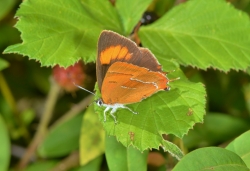 | 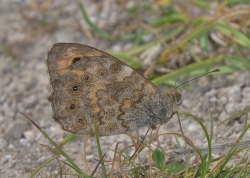 | 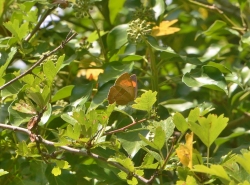 |
| Female Brown Hairstreak one of many seen today. Photo © Ashley Whitlock | Wall Brown underwing very fortunate to get this! Photo © Ashley Whitlock | Can you see me? Photo © Ashley Whitlock |
Miller’s Pond LNR, Southampton. Miller’s Pond LNR this morning (09:15-10:00).
First up this morning I watched a fresh Small Copper battling for territory with a second Small Copper and then almost immediately afterwards spotted a Clouded Yellow!
I continued around then main meadow areas and ended up with 5 Small Coppers, 1 Clouded Yellow, 2 Large Whites, 1 tatty Common Blue, 3 Meadow Browns, 1 fresh Brown Argus, 1 Holly Blue and 1 Red Admiral. I thought that was a pretty good haul for such a short, early visit. [Posted by Nic Burns]
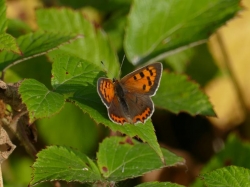 | 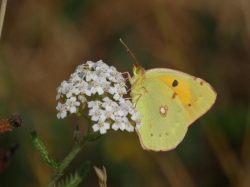 | 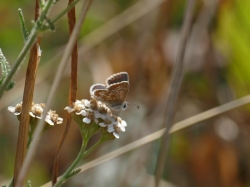 |
| Small Copper Photo © Nic Burns | Clouded Yellow Photo © Nic Burns | Brown Argus Photo © Nic Burns |
Old Winchester Hill. Old Winchester Hill in late August/early September is usually one of my last butterfly trips of the year but I went very early this morning principally looking for autumn migrants (birds) - the less said about how many I saw the better! I very quickly got that 'you should have been here yesterday' type of feeling which often accompanies my infrequent fishing trips. It was surprisingly cloudy on the hill fort - the clouds were so low it felt like I was in them at times but they fortunately broke up for about 10-15 minutes as I got close to the south facing field so couldn't resist a quick circular walk of the slope. The wild flowers are in abundance - very pleasantly surprised thinking they would be burnt off after the last few weeks. The Chalk Hill Blues were in abundance too but I didn't see an Adonis Blue - although to be fair I probably wasn't there long enough to do them justice. I couldn't resist a photo of a beautiful Meadow Brown - it caught the sunlight really well. The real gems though were the Silver-spotted Skippers - I've never seen so many at one site before - every step seemed to throw up at least one skipper if not 2 or three. They undoubtedly saved my day. Closer to home - no sign of the Long-tailed Blues returning - I've spent the last 2-3 days out in the garden looking which has had one advantage - I spotted a Humming bird Hawkmoth earlier in the week and it has returned every day. A photo of it is proving to be a real challenge! [Posted by Mark Wagstaff]
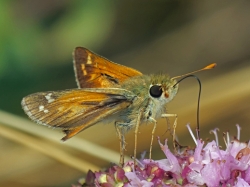 | 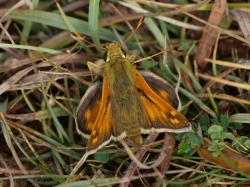 | 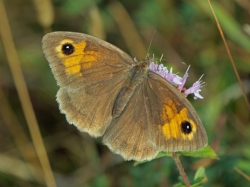 |
| Silver Spotted Skipper - Old Winchester Hill Photo © Mark Wagstaff | Silver Spotted Skipper - Old Winchester Hill Photo © Mark Wagstaff | Meadow Brown - Old Winchester Hill Photo © Mark Wagstaff |
Monks Walk, Frater Fields & Woods, Gosport. Inclement weather put paid to a trip 'up-county' so after the rain stopped it was off to my local patch. Ten species recorded from 1300-1545 (temperature ranged from 21-23 deg C, mostly overcast and humid) although no double figure counts. My first Small Copper sighting for August showed it to be a very fresh specimen and likely second generation. So it was very much a mix of the old and the new today. Total: Small White (7); Holly Blue (5); Large White (1); Common Blue (M)(4); Meadow Brown (7); Red Admiral (2); Small Copper (1); Speckled Wood (4); Gatekeeper (2); Comma (2). [Posted by Francis Plowman]
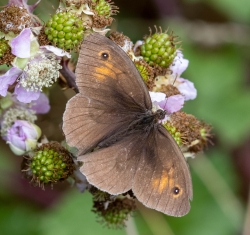 | 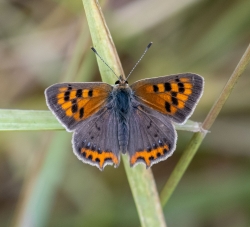 | 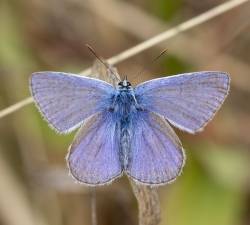 |
| Meadow Brown female Photo © Francis Plowman | Small Copper Photo © Francis Plowman | Common Blue Photo © Francis Plowman |
Butser comes up trumps. I have long thought that Butser Hill looks suitable for Silver-spotted Skipper and having seen a first brood Adonis Blue there in the spring I thought I would pay a visit to see what I could find. The long hot summer has done its work and the turf was crispy underfoot but most is still surprisingly green.
Within fifteen minutes my hunch had paid off and I had found my first Silver-spotted Skipper - very pleasing. A careful count in the area concerned revealed at least nine individuals so it seems they are indeed established. Further on I came across a single Immaculate male Adonis Blue which shone like a jewel in the distance- absolutely no mistaking that one. The valley was teeming with Brown Argus of which I counted in excess of seventy - the hot summer seems to have agreed with them. My last surprise was a second brood Dingy Skipper - seemingly fresh and much lighter than the first brood. A productive day. [Posted by Mark Tutton]
 |  |  |
| Very pleasing to find SSS Photo © Mark Tutton | Gleaming Adonis Blue Photo © Mark Tutton | Second brood Dingy was a surprise Photo © Mark Tutton |
Old Winchester Hill. Visited Old Winchester Hill today to do a count of Silver-spotted Skipper and Adonis Blue, and looked at the western side of the Fort slope. It's very crunchy underfoot due to the drought, but despite this there are plenty of wildflowers surviving on the slopes just showing how resilient they can be! Also there were plenty of butterflies on the wing, and in an hour I counted (15 male and one female Adonis Blues) all of which were in immaculate condition. The Silver-spotted Skipper was also on the wing and these are very hard to count. I had a conservative count of (34) however I did not go all over the western slope, only counting half way up, so this count is probably only about half the total, but I suspect there were many more flying around. I saw several females laying eggs, but due to the low number of rabbits (lack of burrows noted) on this particular part of the site, there are no obvious patches of bare earth and scrapes for the butterfly to lay on sheep's fescue. Only where the sheep tend to walk when they are moving about the site is there bare earth, this is where I actually noted most of the flying and interaction of the males and females today. But these females were obviously finding the sheep's fescue despite this. Other butterflies of note were Common Blue, Small Heath but very little else, certainly no Clouded Yellows, which I normally see on the car-park slope of Old Winchester Hill. [Posted by Ashley Whitlock]
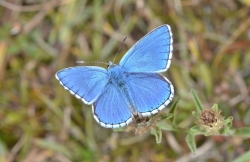 | 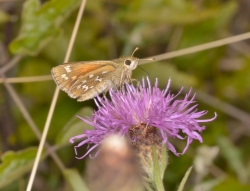 | 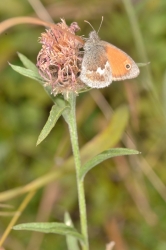 |
| Male Adonis Blue Photo © Ashley Whitlock | Female Silver-spotted Skipper Photo © Ashley Whitlock | Small Heath Photo © Ashley Whitlock |
2nd brood White Admiral!. I've spent quite a bit of time at Pamber Forest over the last few weeks looking for overwintering larvae and, today, found a fresh-out-of-the-pupa 2nd brood White Admiral! A rubbish video of an extraordinary event is here. Some of the larvae I've been monitoring are continuing to feed up and I believe will soon enter their 4th instar - we shall see! An example is attached. [Posted by Peter Eeles]
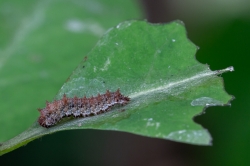 |
| Full-grown 3rd instar White Admiral larva Photo © Peter Eeles |
Long Tailed Blues. Something very special in my Lee on Solent garden yesterday – two Long Tailed Blues! I’ve been planting Everlasting Pea for at least the last 7 or 8 years in the hope of attracting them here. They turn up in Sussex regularly so my logic says they must be on the Hampshire coast too but probably under reported. This year I sowed some new seed in the front garden very late so it’s just coming into flower now – and it appears to have worked! I inadvertently disturbed one on the pea flower itself then when it flew up another appeared from nowhere and chased it. Unfortunately both butterflies were very active (a combination of heat and their own interaction I think) so only settled briefly – but I watched them for long enough for me to be sure at what I was seeing. Naturally I then dashed inside for my camera but they had another ‘ding dong’ when I got back and then disappeared before I could get a photo. Having been lucky enough to see them previously (near Brighton) I’m confident they were LTB’s. My wife also saw them and although no expert – was clear about what we both saw when I got the book out for her. I’ve been sat out watching my small patch of peas since 1000 yesterday (and getting very hot!) but no return visit sadly. I’ll keep looking out for them just in case but the longer they don’t return the more I’m starting to think they were just passing through. [Posted by Mark Wagstaff]
Clouded Yellows at Noar Hill. A return trip to Noar Hill today in the hope of securing some more pleasing photos of the Clouded Yellow came up trumps! With skies slightly more overcast this afternoon compared to the unremitting azure blues of recent weeks, there was plenty to see and to enjoy among the scrapes at the top of Noar Hill, but alas no Brown Hairstreaks showed up along the Blackthorn hedges, as had been the case yesterday - with the weather apparently set to change, perhaps they knew something I didn't! However, the Clouded Yellows certainly didn't disappoint, and once settled, they remained in situ for much longer than in recent days, allowing some decent photos to be taken using my new Leica 100-400mm lens, which seems to have proved its worth already! [Posted by Michael Jameson]
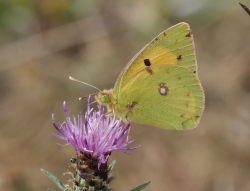 | 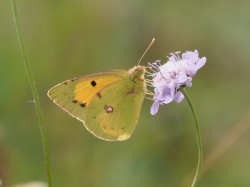 |
| Clouded Yellow at Noar Hill (1) Photo © Michael Jameson | Clouded Yellow at Noar Hill (2) Photo © Michael Jameson |
Noar Hill Field Trip. Another day of melting temperatures, and keeping in the shade was the order of the day. We managed most of the time but we were all suffering somewhat after a few hours and despite not seeing a great deal, we decided to call it a day after about two hours of slow shoe shuffling around a bit of the site. As we started to leave the site I decided to look in the same department where I saw a female Brown Hairstreak last week, and low and behold there was another female in almost the same spot! She wasn't as immaculate as last weeks but this weather must be taking its toll. They must fly up to the tree where males have been seen lekking and get there mating done, and then descend to the ground and wait for me to come along! She brightened up our day, and she opened her wings for us as well. She firstly sheltered under some Dogwood leaves, and then she came out into the open, displaying her upper wings, and then she flew off. There were several others seen as well one in this area, one around an Ash tree, and one over an Apple tree. Other butterflies seen today were several Clouded Yellows, Small Heaths, Common Blues, Meadow Browns and Gatekeepers, Red Admiral, and plenty of Speckled Woods, of which a pair were seen mating on an Apple tree.There was several moths of note one being a Hummingbird Hawk Moth seen at the entrance of the site
I must thank those who braved the weather and hope to see you all soon. [Posted by Ashley Whitlock]
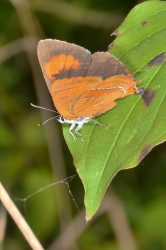 | 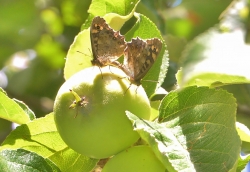 | 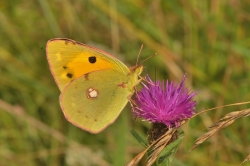 |
| Female opening her wings at Noar Hill Photo © Ashley Whitlock | Mating Speckled Woods on an Apple Tree Photo © Ashley Whitlock | Clouded Yellow Photo © Ashley Whitlock |
Jersey Tiger. A large stand of Hemp Agrimony along the Test Way, near the Stoneymarsh car park, prompted a visit to see what butterflies might be nectaring. There were in fact very few, but our brief exploration was amply rewarded, as Linda spotted a Jersey Tiger moth nectaring on Spearmint. This is the first time we've seen this species in Hampshire, but as reported on pg.62 of the 2021 Hampshire & Isle of Wight Butterfly Report, it's a species becoming more established in south Hampshire, and slowly extending it's range inland. The individual we saw had the yellowy-orange hindwing ground colour (f.lutescens) compared with the typical form that has red ground colour. The first two images show the individual seen today, whereas the third image, taken at Mapperton, Dorset, in 2016, shows the red hindwing (slightly faded) for comparison. [Posted by Andy Barker]
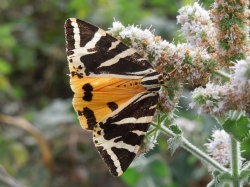 | 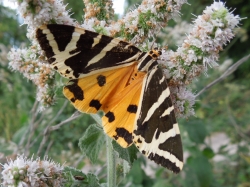 | 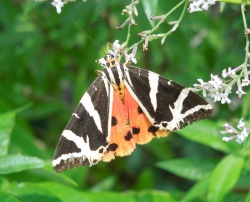 |
| Jersey Tiger (f. lutescens) Photo © Andy Barker | Jersey Tiger (f. lutescens) Photo © Andy Barker | Jersey Tiger (typical form) Photo © Andy Barker |
Thirty up. It might be ONLY a Small Heath but it is the thirtieth species I have seen within the boundaries of the City of Portsmouth. Not a bad tally for the most densely populated city outside of inner London? I targeted a number of missing species this year and this was the final one, of which I spotted a number on Farlington Marshes. Quite appropriate really as my interest in the natural world was fostered by my junior school teacher, Miss Geary, who gave up her time at weekends to take us on nature rambles to ‘the marshes.’ I owe her a deep debt of gratitude.
I have also been wandering the lanes around Southwick, Newtown and Soberton looking for Brown Hairstreak and turned up a female on this section of Blackthorn Rich hedgerow at Newtown but she was chased off by a common blue before I could take a snap. The Southwick estate has miles of Blackthorn hedging which seems to be reasonably sympathetically managed and I am sure these hairstreaks are fairly well distributed in this area if at low numbers. [Posted by Mark Tutton]
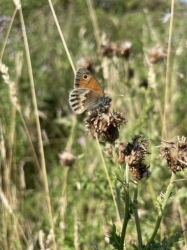 | 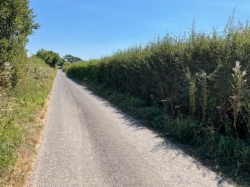 |
| No 30 Photo © Mark Tutton | Brown Hairstreak territory Photo © Mark Tutton |
Browndown (South), Gosport. Given the prevailing conditions we were pleasantly surprised to be able to see seven species if not going strong, at least going! From 1250-1445 (30 deg C) we did a broad circuit of the main heath and northerly perimeter, once again restricted by the model aircraft club (one of whose aircraft had spectacularly crashed and was written off on the verge of the main Lee on the Solent road!). The heather is just about dried-out with just a patch here and there showing a little colour. Underfoot it sounded like walking on fresh snow so dry and crunchy the surface. The one Purple Hairstreak was clearly observed flying between two large oaks on the northerly perimeter path. Total: Small White (9); Meadow Brown (6); Small Heath (7); Grayling (1); Common Blue (M)(5); Purple Hairstreak (1); Holly Blue (2). [Posted by Francis Plowman]
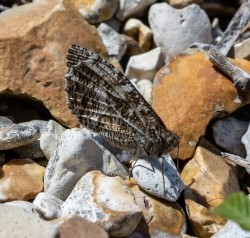 | 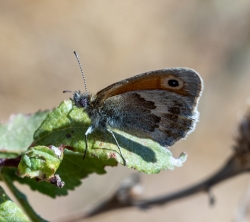 | 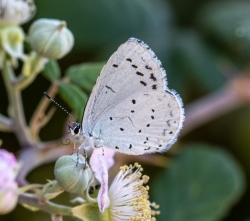 |
| Grayling Photo © Francis Plowman | Small Heath Photo © Francis Plowman | Strongly marked Holly Blue on blackberry blossom Photo © Francis Plowman |
Ackender Wood, Alton. Pretty quiet in Ackender Wood - for insects generally, not just butterflies. However two Spotted Flycatchers were notable.
There was a single well-worn Silver-washed Fritillary, but the only other vanessid was a single Red Admiral.
While trying to get to grips with hoverflies on a patch of umbellifers by the main ride, I chanced on this Brown Hairstreak.
SU7038 [Posted by Steve Mansfield]
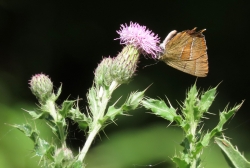 | 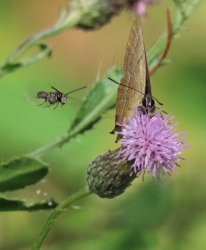 |
| Brown Hairstreak, Ackender Wood Photo © Steve Mansfield | Brown Hairstreak, Ackender Wood Photo © Steve Mansfield |
A scorching visit to Noar Hill!. Despite soaring temperatures already by 10:30 this morning, we decided to visit Noar Hill - if all else failed, there remained the prospect of a decent pub lunch in Selborne! It was 34C by the time we reached the scrapes at the top, but despite that, there were abundant signs of activity, with several fly-bys by at least 5 stunning Clouded Yellows, none of whom seemed inclined to rest up for more than a fleeting moment (hence the less than perfect photo below), whilst the Brown Hairstreaks were sensibly keeping to cover on the descending track from the road below. This one obliged by staying put for several minutes whilst nectaring. [Posted by Michael Jameson]
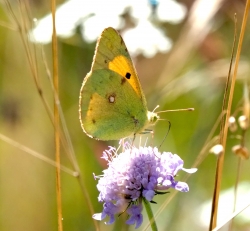 | 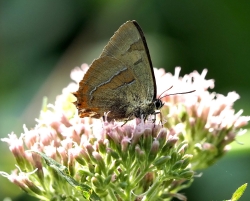 | 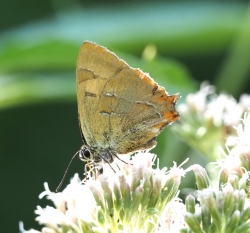 |
| Clouded Yellow at Noar Hill Photo © Michael Jameson | Brown Hairstreak (1) Photo © Michael Jameson | Brown Hairstreak (2) Photo © Michael Jameson |
Thirty up in City of Portsmouth. It might be ONLY a Small Heath but it is the thirtieth species I have seen within the boundaries of the City of Portsmouth. Not a bad tally for the most densely populated city outside of inner London? I targeted a number of missing species this year and this was the final one, of which I spotted a number on Farlington Marshes. Quite appropriate really as my interest in the natural world was fostered by my junior school teacher, Miss Geary, who gave up her time at weekends to take us on nature rambles to ‘the marshes.’ I owe her a deep debt of gratitude.
I have also been wandering the lanes around Southwick, Newtown and Soberton looking for Brown Hairstreak and turned up a female on this section of Blackthorn Rich hedgerow at Newtown but she was chased off by a Common Blue before I could take a snap. The Southwick estate has miles of Blackthorn hedging which seems to be reasonably sympathetically managed and I am sure these hairstreaks are fairly well distributed in this area if at low numbers. [Posted by Mark Tutton]
 |  |
| No 30 Photo © Mark Tutton | Brown Hairstreak territory Photo © Mark Tutton |
Old Winchester Hill. Sixteen days ago on this site we found no sign of Silver-spotted Skipper nor Adonis Blue. Today both were easily found (though harder to photograph). From the top of the car park slope to the bottom, the SSS was present and the Adonis Blue located more towards the valley floor. From 1130-1310 with the temperature 27.5 degrees Celsius and rising some 13 species were recorded. Part of the valley side is now fenced for a few sheep to graze away although in today's heat they were making use of the wooded shade at the end of the valley path. Total: Chalk Hill Blue (M)(78)(F)(9); Meadow Brown (106); Common Blue (M)(20)(F)(7); Gatekeeper (5); Silver-spotted Skipper (13); Small Heath (6); Clouded Yellow (4); Adonis Blue (M)(14)(F)(1); Brown Argus (2); Dark Green Fritillary (1); Large White (1); Brimstone (M)(1)(F)(2); Small White (1). [Posted by Francis Plowman]
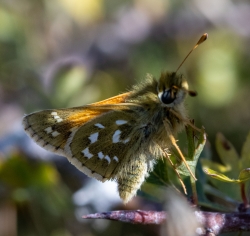 | 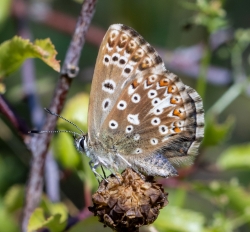 | 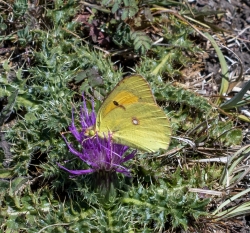 |
| Silver-spotted Skipper possibly female in the shade Photo © Francis Plowman | Heavily marked and fresh Adonis Blue female Photo © Francis Plowman | Clouded Yellow male Photo © Francis Plowman |
Convolvulus Hawk Moth Sighting, IoW. Hi there, I didn't get a picture but I saw it on my Nicotiana bush last night at 10pm in my garden in Thorley, West Isle of Wight, hovering and drinking the nectar. I immediately recognised it as a Convolvulus Hawk Moth, really big, huge proboscis, the kitchen light was on and I was sitting outside, it had only just got dark. Beautiful :) Anyway, thought I should let someone know.
Kind regards
Jessica Streeter [Posted by Jessica Streeter]
Selbourne Hill and Noar Hill. I visited today a site I know a lot of people do not visit, one because it is a bit of a hike from the car-park in Selborne, but from Noar Hill it really is a lot easier. Selborne Hill is a large woodland owned by the National trust. There is a lot of mature Oak and Beech trees with a few mature Ash trees which at the moment seem to be ok from Ash dieback. In the height of summer would produce some good sightings of the major butterflies like Purple Emperor and White Admiral and Silver-washed Fritillary. I saw one Silver-washed Fritillary today feeding on some very ripe Bramble berries. There's a lot of Blackthorn in the field margins, and on Selborne Common there is also good amounts as well along with Cowslip in the Spring. I didn't see the Brown Hairstreak here today but I know it is recorded here, so is the Duke of Burgundy in the spring. Worth bearing in mind if you want a change from Noar Hill anytime. On Noar Hill today in blazing hot sunshine I kept my head in the Hazel cover whenever I could, seeing Common Blue, Small Heath, Brown Argus, Clouded Yellow, Whites, a couple of Small Skippers, and my quarry turned up just as I was leaving the site, a lovely female Brown Hairstreak. She was a hot butterfly, as she was sheltering underneath Hazel leaves when she settled down. She was a beaut, probably only a day old. I don't hear of many sightings of this butterfly here of late, but it's still here, and I suspect she had just mated, and was going off to lay eggs on many 'new' areas of fresh Blackthorn which I had seen earlier. Good Luck girl! [Posted by Ashley Whitlock]
At Last on Portsdown Hill. Over the last few winters I have searched for, and found, a handful of Brown Hairstreak eggs on Portsdown Hill so I know they are there. Consequently I have spent many hours trying to find an adult during their flight period. Today I came up trumps with a pristine female. She was found prospecting for egg laying locations on a long Blackthorn rich hedgerow some way away from where I have previously found eggs - a very nice surprise. Now to find the male lekking tree! [Posted by Mark Tutton]
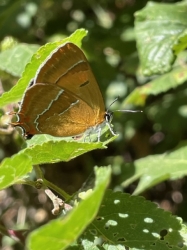 |
| Perfect Photo © Mark Tutton |
Scarce swallowtail in the New Forest. Only a month after watching Scarce Swallowtails at Monserat in Spain, I was amazed to see one fluttering across my garden in the New Forest, near Burley.
I’ve not seen any other migrants here this year yet, so was very surprised to get my first time ever British sighting. [Posted by Alan Hobbs]
Shipton Bellinger & Broughton Down. A really good day out yesterday.
07:30-11:15 Shipton Bellinger for Brown Hairstreaks and Wall Browns.
I saw 6 or 7 BH's, presumably males, high up along the track up from Shipton Bellinger and this rather tatty female along the northern side of the triangular field which thankfully came down for a close up. 15-20 Walls but they were mainly settling with closed wings presumably due to the heat.
12:15-14:30 Broughton Down for Silver-spotted Skippers.
On arrival I sat down for lunch just inside the nature reserve and was immediately joined by a SSS. I saw 20+ SSS on my wanderings and was pleased to see good numbers of Common Blues (especially females), Brown Argus and Chalk Hill Blues along with a few Adonis Blues, Small Heath, Brimstone, Meadow Browns and two very worn Dark-green Fritillary. [Posted by Nic Burns]
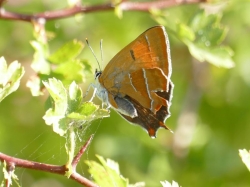 | 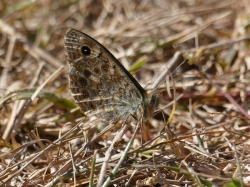 | 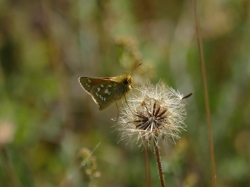 |
| Brown Hairstreak Photo © Nic Burns | Wall Photo © Nic Burns | Silver-spotted Skipper Photo © Nic Burns |
Meon Valley Hairstreaks. In searing temperatures I paid a visit to a site in the Meon valley where I saw a female Brown Hairstreak last year and it came up trumps. Five males were active in a large Ash ‘master tree’ which has, so far, thankfully avoided Ash die-back. In addition I watched at least three females actively seeking out egg laying opportunities in the plentiful Blackthorn suckers. There was also a very late Dark Green Fritillary, somewhat worse for wear, but he was still chasing off all comers! I visited a second site on the way home that also looks promising for Brown Hairstreak, but no luck so far. [Posted by Mark Tutton]
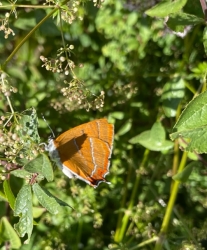 | 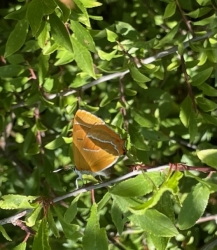 | 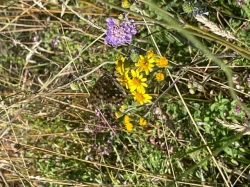 |
| Hairstreak 1 Photo © Mark Tutton | Hairstreak 2 Photo © Mark Tutton | Tatty warrior Photo © Mark Tutton |
Fort Widley and garden. Looked around Fort Widley in very warm sunshine today to see if I could espy the Brown Hairstreak, however I was out of luck today, and I also remembered the area I walked was also good for the Wall Brown several decades ago so if the Wall is making come back it would be most welcome on my old transect route thankyou! The area is full of Blackthorn thickets and good meadows full of wildflowers albeit all dying off due to the drought. Common Blue was seen and Brown Argus, Meadow Brown and Gatekeeper, Whites, Commas and Red Admiral, but nothing to get the heart rate racing. Back in my garden I was visited by a lovely Jersey Tiger Moth feasting on the last of the Buddleia flowers. On my front door I believe was a wave moth. [Posted by Ashley Whitlock]
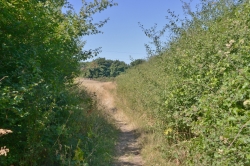 | 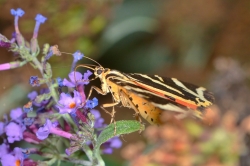 | 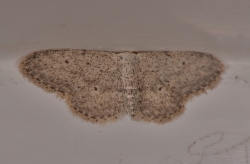 |
| Brown Hairstreak area close to Fort Widley Photo © Ashley Whitlock | Jersey Tiger Moth on Buddleia Photo © Ashley Whitlock | Small Dusty Wave Photo © Ashley Whitlock |
Shipton Bellinger. It must be 3 years and definitely pre covid since I visited Shipton Bellinger. I went today as much for the Wall Browns reported there as the Brown Hairstreaks. The latter were playing hard to get - plenty high up but I couldn't find any low down. The former though were a revelation! The last Hampshire Walls I saw were on the Ancient Highway near Lymington many years ago and apart from the odd singleton wanderer (including in my own Lee on Solent garden) they seem to have been few and far between in recent years. There have though been reports of them at Shipton (and the surrounding area) for a couple of years now so it was great to see them really well established here. I saw them across much of the site - starting from where the path up from the village divides into two right across to the boundary hedge. I'm hopeless at counting (birds or butterflies) but must have seen 20+ minimum - and most in good condition. So, despite not seeing a Brown Hairstreak at eye level, a wonderful day. [Posted by Mark Wagstaff]
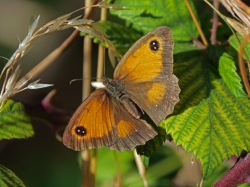 | 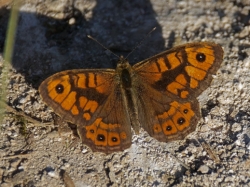 | 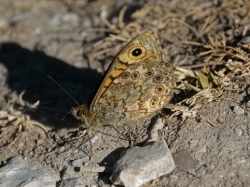 |
| Gatekeeper - Shipton Bellinger Photo © Mark Wagstaff | Wall Brown- Shipton Bellinger Photo © Mark Wagstaff | Wall Brown - Shipton Bellinger Photo © Mark Wagstaff |
St Catherine's Hill. Early evening is one of the best times to visit our south facing downland sites during this hot weather. The butterflies are often more ready to settle and the light can be better for photographs.
We managed to find a few Silver-spotted Skipper and a single Clouded Yellow, plus many Chalk Hill Blue and Meadow Brown, with smaller numbers of Brown Argus, Common Blue, Small Tortoiseshell, Gatekeeper and Small Heath. [Posted by Rupert & Sharron Broadway]
Unexpected sighting in North Baddesley. Seen today on my reserve at North Baddesley was Wall Brown, I saw one here 2 years ago but not a clue where they are coming from. Also seen today Clouded Yellow, Painted Lady, Chalk Hill Blue, Brown Argus, Small Heath, Silver-washed Fritillary, Peacock, Small Tortoiseshell, Red Admiral, 12 Common Blue, Brimstone, Holly Blue, Comma, Meadow Brown, Ringlet, Small White, Large White, many Gatekeeper. Does not seem too bad considering the conditions. Now seen 32 different butterfly species here so far this season. [Posted by Kevin Ross]
Oxenbourne Down. A short trip up to one of my local chalk downland patches and the butterflies didn't disappoint. Up to 35 Silver-spotted Skippers were seen whizzing about and feeding up, laying eggs and also mating. The Chalk Hill Blue was also in enormous numbers, but everything looks very dry and barren in places. I looked in on some of 'my' Cowslip patches and they have shriveled up to almost nothing, I just hope this isn't detrimental to the Duke of Burgundy colonies on site, next year should could prove very interesting in regards to numbers. We've had dry summers before, and the Duke of Burgundy can survive on the north facing slopes better, due to the fact they are not facing towards the sun. Other species seen were one female Dark Green Fritillary, Gatekeeper, Common Blue, Small Heath, Meadow Brown, Ringlet. No Brimstones were seen and the Vanessids seem to have dived into hibernation really early. [Posted by Ashley Whitlock]
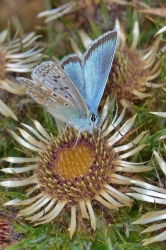 | 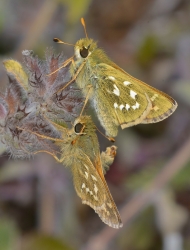 | 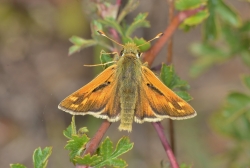 |
| Male Chalkhill Blue Photo © Ashley Whitlock | Love is in the air............... Photo © Ashley Whitlock | Little fighter Jet Photo © Ashley Whitlock |
White Admiral larvae. I had several visits to Pamber Forest over the last few weeks, where I monitor White Admiral larvae - with 48 larvae now located. With the distinctive feeding damage and constructions created by the larvae, I'm able to confirm that another 10 larvae have already disappeared - presumed predated. However, all larvae are now in either their 2nd or 3rd instar and I have high hopes that most will make it to the point where they create a hibernaculum from a Honeysuckle leaf, in which they will overwinter. A few larvae are already in the process of doing this, indicating that this is a particularly early year for this butterfly. [Posted by Pete Eeles]
The Wrong Hairstreak. Having put in the hard yards searching for Brown Hairstreak eggs at Stockbridge Down back in the winter, we went back to search, unsuccessfully, for adults today.
We did, instead, encounter a White-letter Hairstreak in remarkably good shape. There were phenomenal numbers of Chalk Hill Blue on the wing, together with varying counts of Brimstone, Large White, Clouded Yellow, Common Blue, Gatekeeper, Meadow Brown, Small Heath and Speckled Wood: and singles of Small Copper, Comma, Small Tortoiseshell and Silver-washed Fritillary. [Posted by Rupert & Sharron Broadway]
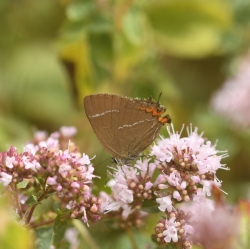 | 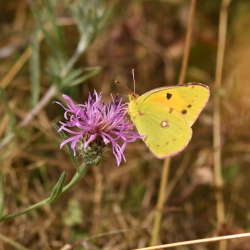 |
| White-letter Hairstreak at Stockbridge Down Photo © Rupert & Sharron Broadway | Clouded Yellow at Stockbridge Down Photo © Rupert & Sharron Broadway |
Bedlam Plantation. A visit to a lesser known area on the Hampshire side of the large Army ranges in and around Tidworth close to Shipton Bellinger. The weather was warm but overcast most of the time with very little breeze which to me is perfect conditions for butterfly watching. Arriving just before midday the butterflies were in full swing and the first butterflies seen were two Wall Browns both chasing each other, a territory dispute I suspect, this put me in the mood to find more. There were plenty of Brimstones, Brown Argus, Common Blues, Gatekeepers, Meadow Browns and Small Heaths, also a couple of Silver-spotted Skippers. The Walls just kept on coming and on the edge of a farmers field where there were sufficient areas of wildflowers, these areas produced up to twenty odd Wall Brown's over a course of a couple of hours. On the way back to the car-park, I espied a female Brown Hairstreak which was fresh as a daisy, and also there were still Wall Browns to be seen and females were also seen being much larger than the males and were easy to Identify, feeding on Thistles. Probably one of the most satisfying 'mini' field trips I've ever done, a big plus for Military sites which are largely untouched by pesticides and other nasties and are full of hedgerows, with blackthorn and birds song plenty of Ravens were heard and Yellowhammers, and Long Tailed Tits, chattering in amongst the hedges. [Posted by Ashley Whitlock]
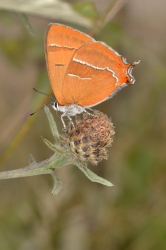 | 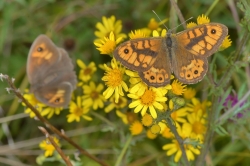 | 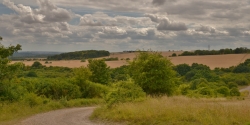 |
| Female Brown Hairstreak Photo © Ashley Whitlock | Wall Brown and Meadow Brown Photo © Ashley Whitlock | Army range close to Tidworth Photo © Ashley Whitlock |
Stockbridge Down Part 1. Thirteen species recorded on an extended walk (1140-1420) over the western and northern ranges of the down. Under grey skies, a drop or two of rain with the temperature around 21 degrees Celsius the butterflies were in abundance. We decided to keep a full count of the Chalk Hill Blue and Meadow Brown which species were very prominent indeed. Total: Meadow Brown (178); Chalk Hill Blue (M)(839)(F)(64); Gatekeeper (20); Speckled Wood (3); Small Heath (6); Marbled White (M)(1); Green-veined White (M)(1)(F)(1); Common Blue (M)(2); Large White (3); Small White (2); Dark Green Fritillary (3); Brimstone (M)(1); Holly Blue (1). [Posted by Francis Plowman]
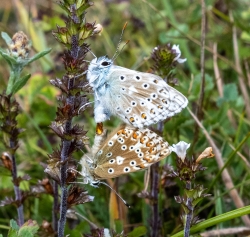 | 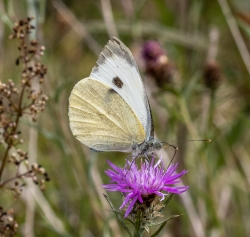 | 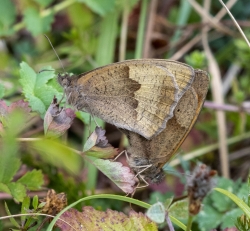 |
| Chalk Hill Blue (female lower) Photo © Francis Plowman | Large White male Photo © Francis Plowman | Meadow Brown female at left Photo © Francis Plowman |
Stockbridge Down Part 2. From 1455-1620 we covered the southern and eastern expanses of the down determining to put a 'cap' on the numbers of the predominant butterflies! There was initially some warm sunshine but it was soon replaced by grey clouds with a pleasant temperature around 23 degrees Celsius. Ten species were recorded. Total: Chalk Hill Blue (M)(60+)(F)(55+); Meadow Brown (55+); Common Blue (M)(11)(F)(1); Small White (6); Small Heath (4); Large White (3); Adonis Blue (M)(1); Gatekeeper (2); Silver-washed Fritillary (M)(1); Speckled Wood (M)(1). [Posted by Francis Plowman]
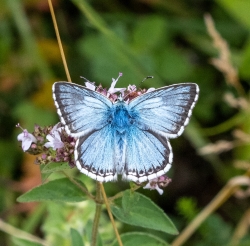 | 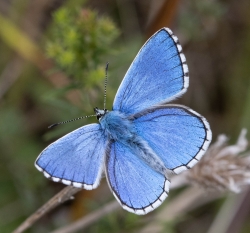 | 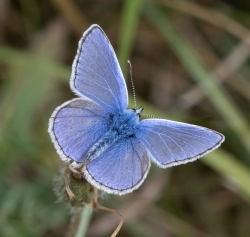 |
| Chalk Hill Blue male Photo © Francis Plowman | Adonis Blue male Photo © Francis Plowman | Common Blue male Photo © Francis Plowman |
Moth trap in my garden at Leigh Park. I had my moth trap on overnight in my garden in Leigh Park. Some of the highlights included Jersey Tiger, 12 Garden Tiger, Gold Spot, 2 Tree-lichen Beauty, Marbled Green, a female Oak Eggar, 2 Rosy Rustic, Lesser Swallow Prominent, Spectacle etc. [Posted by Barry Collins]
Unusual butterfly??. This butterfly flew into and out of my conservatory door around 12.30 today and is now settled on small plant in the garden. Nearest thing on ID sites that I can find is a Scarce Swallowtail? [This has been identified as a Jersey Tiger moth - P. Eeles] [Posted by Phyllis Toms]
North side of Portsdown. On my fifth attempt this year I managed to observe a brown hairstreak whizzing around the top of the trees shortly after 1300 before it settled about 10m up a tall ash tree. Hopefully there will be a few more in the weeks to come. A single purple hairstreak was also seen despite the lack of oaks. [Posted by Peter Gammage]